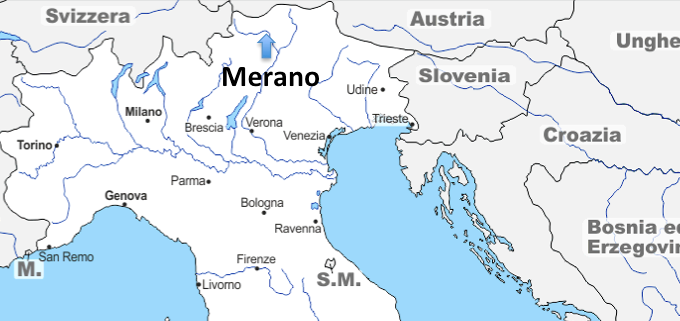
A European Journey #33 – Merano (Italy)
Today we will visit Merano, an Italian town in the region of South Tyrol. It is located right at the heart of the Dolomite Mountains.
If you walk across the town, you might be surprised to hear many people speaking German. This is because the town, which is called Meran in German, was still part of Austria until the end of World War I. The idyllic surroundings and the mild climate have brought several famous people here, including the Empress Elizabeth of Austria and the writer Franz Kafka.
As I said last week, we will continue looking for stories of how pagan tribes converted to Christianity in Europe.
Starting from the St. Nicholas’ church in the Piazza Duomo, we will walk through the tiny streets of the old town and under the Porta Passiria, which is one of the three thirteenth century gates still existing today in the town. Then we will walk up a hill for half a kilometre to reach a castle called Castel San Zeno (Zenoburg in German), which overlooks the river Passirio (Passer). From this place there is a panoramic view over the town and we can admire the beautiful mountains.
Like the gates, the castle was built in the thirteenth century, and is more recent than the period of history we will be looking at today. We are in fact going to turn to the fifth century, a time when the Germanic tribes were sweeping into the Western Roman Empire. While other places of Italy were being ransacked, Merano tells us a different story.
Last week in Bulgaria, we saw that the Goths became the first Germanic tribes to turn away from paganism, even though they turned to Arianism (a Christian heresy) instead of Christianity. Although the Council of Nicaea had condemned the heresy in 325, it continued to spread among other Germanic tribes, such as the Alans, the Vandals or the Suevi, to name but a few.
In the fifth century AD lived a man known today as Valentine of Passau. His name can be somewhat misleading. First of all, he is not the man celebrated on Valentine’s Day. And while his name is associated with the German town of Passau, it was in reality here in Merano that his work was more fruitful.
So who was Valentine of Passau?
His origins are not certain. Modern scholars think he was probably born in modern-day Netherlands. The first traces we find of him are in fact in Passau, Germany, where he was living among a Germanic tribe. And this is obviously why he got his name. At the time, these people were either pagan or Arian. Actually, Valentine seems to have been the only one in town to believe that Jesus was God.
This was probably why he desired to become a missionary among them. Since Valentine considered it indispensable to be blessed by a church authority, he set out to Rome to ask for the blessing of Pope Leo I. As soon as he received it, he returned to Passau to begin his work.
Sadly, the Arian opposition seemed to be so serious that Valentine didn’t have much success. Later on, he returned to Rome to ask for a transfer to another territory where he could be more fruitful. Leo, however, challenged him to go and try again. The pope also ordained him as Bishop of Rhaetia, an alpine region covering parts of Germany (up to Regensburg and Passau), Switzerland (up to Chur and the Saint-Gotthard pass), and Italy (up to Bressanone).
Valentine’s new title didn’t seem to impress the people of Passau much however. The situation worsened so much that his personal security was endangered. Finally he was forced to flee from Passau. After crossing the Alps, he decided to retire on the top of Monte San Zeno where we are today.
We can imagine how defeated and discouraged Valentine must have felt when he arrived here. Probably feeling that he had failed in his mission, Valentine decided to live as a hermit. Perhaps he thought that worshipping God in a quiet remote place was the best he could do.
Valentine had planned to live a solitary life on the top of this mountain. But instead, people from surrounding areas began to be curious about him. Soon crowds flocked to hear him preach the Word of God. Valentine baptized many people, probably in the river just at the foot of the mountain. Some even became his disciples, and Valentine taught them to follow his ascetic lifestyle, which was a rhythm of prayer, contemplation, almsgiving and reading. Later on, Valentine and his disciples built a church building right here. And this is where he finally passed away in 475 and was buried on this site. Several centuries later, the Castel San Zeno was built to protect this church. And the town of Merano later developed around it to become what it is today.
In a time when anarchy seemed to take over in Europe, this little community on Monte San Zeno became one of the first places where Christianity brought security, order and peace after the fall of the Roman Empire. One can only wonder what this continent would have looked like without the work of these pioneers.
Finally, although Valentine’s mission to Passau seemed like a failure, we will discover next week how God redeemed the situation.
See you next week somewhere else in Europe.
Cédric Placentino
Schuman Centre convener for Italian and French Europe
Follow A European Journey here.

This Post Has 0 Comments